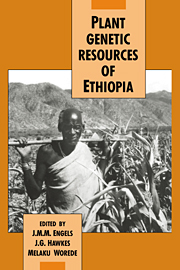Book contents
- Frontmatter
- Contents
- Contributors
- List of acronyms
- Preface
- Part I General introduction
- Part II The Ethiopian centre of diversity
- 2 The Ethiopian gene centre and its genetic diversity
- 3 Crops with wild relatives found in Ethiopia
- 4 Diversity of the Ethiopian flora
- 5 Forest genetic resources of Ethiopia
- 6 Plants as a primary source of drugs in the traditional health practices of Ethiopia
- 7 Traditional aromatic and perfume plants in central Ethiopia (a botanical and ethno-historical survey)
- 8 Spice germplasm in Ethiopia
- 9 A diversity study in Ethiopian barley
- 10 Sorghum history in relation to Ethiopia
- 11 Prehistoric Ethiopia and India: contacts through sorghum and millet genetic resources
- 12 Konso agriculture and its plant genetic resources
- Part III Germplasm collection and conservation in Ethiopia
- Part IV Evaluation and utilization of Ethiopian genetic resources
- Index
11 - Prehistoric Ethiopia and India: contacts through sorghum and millet genetic resources
Published online by Cambridge University Press: 30 October 2009
- Frontmatter
- Contents
- Contributors
- List of acronyms
- Preface
- Part I General introduction
- Part II The Ethiopian centre of diversity
- 2 The Ethiopian gene centre and its genetic diversity
- 3 Crops with wild relatives found in Ethiopia
- 4 Diversity of the Ethiopian flora
- 5 Forest genetic resources of Ethiopia
- 6 Plants as a primary source of drugs in the traditional health practices of Ethiopia
- 7 Traditional aromatic and perfume plants in central Ethiopia (a botanical and ethno-historical survey)
- 8 Spice germplasm in Ethiopia
- 9 A diversity study in Ethiopian barley
- 10 Sorghum history in relation to Ethiopia
- 11 Prehistoric Ethiopia and India: contacts through sorghum and millet genetic resources
- 12 Konso agriculture and its plant genetic resources
- Part III Germplasm collection and conservation in Ethiopia
- Part IV Evaluation and utilization of Ethiopian genetic resources
- Index
Summary
Introduction
Several publications have dealt with India's cultural contacts with western, central and south-east Asian countries, but little information is available on India's contacts with African countries (Asthana, 1976). This is understandable because little archaeological work has been done on Neolithic to Iron Age sites in Africa, compared with Asia. Even in India, where several Neolithic-Chalcolithic sites have been excavated, archaeologists have continued to look for some kind of west Asian similarity/influence in interpreting their findings. Thus, even (a) the finds of human skeletons showing Hamitic-negroid features associated with the Langhanag (Gujarat) microlithic culture (Sankalia, 1962); (b) terracotta head-rests discovered in Neolithic burials at Narsipur (ca. 1800 BC), Hammige, Hallur (ca. 1800 BC) and Paklihal in the Kaveri and Krishna basins, showing affinity with similar objects found in Africa and Egypt (Nagarajarao, 1975); and (c) archaeological finds of African crop plants (Vishnu-Mittre & Savithri, 1982) have been ignored. Evidences for indigenous origin(s) of few, or even several, Neolithic – Chalcolithic cultures of India have been recently discussed but with bitter controversy (Possehl, 1982). African millets were incorporated into the cropping system of Chalcolithic farming communities of India, and these may provide evidence of contacts between India and Ethiopia where agriculture was practised (ca. third millennium BC).
- Type
- Chapter
- Information
- Plant Genetic Resources of Ethiopia , pp. 160 - 168Publisher: Cambridge University PressPrint publication year: 1991



